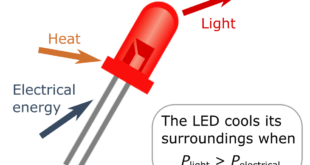Various techniques used in biophotonics have been developed in an industrial or military setting before migrating to medicine and the life sciences. This is one reason why many techniques and applications used in biophotonics are open for dual use, i.e. can in principle be used for both civilian and military …
Read More »Thermophotonics cooling with light-emitting diodes
Thermophotonics (often abbreviated as TPX) is a concept for generating usable power from heat which shares some features of thermophotovoltaic (TPV) power generation. Thermophotonics was first publicly proposed by solar photovoltaic researcher Martin Green in 2000. However, no TPX device is known to have been demonstrated to date, apparently because …
Read More »DARPA EMBER employing Microbes for bioproduction of Rare Earth Elements (REEs)
REEs are a series of chemical elements found in the Earth’s crust that are essential components of many technologies, including electronics, computer and communication systems, transportation, health care, and national defense. Rare Earths Elements (REE) are incorporated into many sophisticated technologies with both commercial and defense applications including smartphones and flatscreen …
Read More »Nanocoatings for consumer and military electronic devices
Nanotechnology is an industry that has recently begun to offer breakthrough solutions to the world. The incorporation of nanomaterials into thin films, coatings and surfaces leads to new functionalities, completely innovative characteristics and the possibility to achieve multi-functional coatings and smart coatings. The use of nanomaterials also results in performance enhancements …
Read More »Nanocoatings provide multiple functionalities in the aerospace, defense, medical, and marine applications
Nanotechnology is an industry that has recently begun to offer breakthrough solutions to the world. The incorporation of nanomaterials into thin films, coatings and surfaces leads to new functionalities, completely innovative characteristics and the possibility to achieve multi-functional coatings and smart coatings. The use of nanomaterials also results in performance enhancements …
Read More »Military CNS Technology growth
CNS (Communication, Navigation, and Surveillance) comprises a vast portfolio of electronic components and technologies utilized for communication, navigation, and surveillance, which are offered under a single platform. Communication comprises tactical wireless headset; personal radio; field digital switchboard; field telephones; HF, VHF, and UH-combat net radios; and antenna multi-couplers; among others. …
Read More »Aircraft Antennas Requirements and market growth
Antennas are used for a huge range of applications, from mobile phones and “smart” WiFi-connected appliances to GPS and systems that track aircraft and help pilots land safely. Over the years, several distinct types of antennas have come into common use, with designs, frequencies and operating power levels that depend …
Read More »Aeronautical Ad-hoc Network (AANET)
The future of aviation worldwide is one of significant continuing growth in air travel, air cargo, and private general aviation. In parallel with this growth, a significant increase in the supporting information infrastructure will need to occur. The infrastructure will support two primary functions: aviation operational needs (which includes airline …
Read More »3D Radars for Counter stealth Aircraft, Counter Unmanned Aircraft Systems (C-UAS) to Air and Missile defence systems
Radar, electromagnetic sensor used for detecting, locating, tracking, and recognizing objects of various kinds at considerable distances. It operates by transmitting electromagnetic energy toward objects, commonly referred to as targets, and observing the echoes returned from them. Energy is emitted in various frequencies and wavelengths from large wavelength radio waves to …
Read More »Quantum Memory for Quantum Computers
Just as classical computers are unthinkable without memories, quantum memories will be essential elements for future quantum information processors. Quantum memories are devices that can store quantum information for a long time with very high fidelity and efficiency. Quantum memories are devices that can store the quantum state of a photon, …
Read More » International Defense Security & Technology Your trusted Source for News, Research and Analysis
International Defense Security & Technology Your trusted Source for News, Research and Analysis







